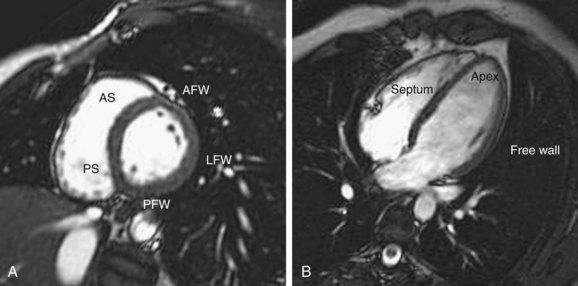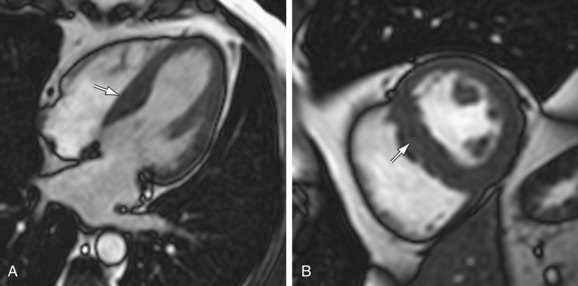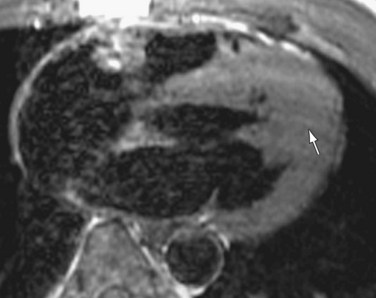CHAPTER 64 Hypertrophic Cardiomyopathy
PREVALENCE AND EPIDEMIOLOGY
The incidence of HCM is reported to be as high as 1/500 individuals, making it the most common genetically inherited cardiovascular disease.1 Nevertheless, HCM is thought to represent no more than 1% of cardiac outpatients,1 suggesting that many genetically affected individuals remain asymptomatic for most or all of their lives.
ETIOLOGY AND PATHOPHYSIOLOGY
HCM is inherited as an autosomal dominant trait with variable penetrance. The distribution of hypertrophy in HCM is variable, with septal, right ventricular, left ventricular, septal, apical, midventricular, or concentric patterns. Asymmetric hypertrophy of the ventricular septum is by far the most common.2 Histologically, HCM is characterized by myofibrillar disarray.1
MANIFESTATIONS OF DISEASE
Clinical Presentation
The clinical presentation of HCM varies from asymptomatic to sudden cardiac death, which is the leading cause of mortality in affected patients. HCM is responsible for approximately one third of cases of sudden cardiac death in young athletes.3 The mechanism for sudden cardiac death is ventricular fibrillation.4 The 1-year mortality rate for clinically evident HCM is approximately 1% to 4%.2 Risk stratification has been advocated to help define those patients who may benefit most from antiarrhythmic therapy or an implantable cardiac defibrillator.4 Ventricular wall thickness more than 30 mm has been shown to be an independent risk factor for sudden cardiac death.5 The positive predictive value of hypertrophy more than 30 mm is greatly increased when other risk factors are taken into account.6 More than 90% of patients with HCM have asymmetric septal hypertrophy. Other distributions of hypertrophy include apical, midventricular, and concentric.
In addition to sudden cardiac death, atrial fibrillation and heart failure represent the major morbidities associated with HCM. Atrial fibrillation is encountered in up to 25% of patients.1 Heart failure in HCM is most often caused by diastolic dysfunction. In patients with significant septal hypertrophy, heart failure may also be attributed to left ventricular outflow tract obstruction.2
Imaging Techniques and Findings
Ultrasound
Patients clinically suspected to have hypertrophic cardiomyopathy are initially referred for echocardiography.2 Asymmetric septal hypertrophy is the most common finding. Septal thickening of 13 to 15 mm or more and a septal-to-posterior wall ratio of 1.5 : 1 or higher have been the usual definitions of septal hypertrophy.7 In general, however, any abnormal hypertrophy noted on echocardiography that is not otherwise explained raises the suspicion of HCM.
Computed Tomography
Computed tomography (CT) has been shown to demonstrate morphologic and functional abnormalities in HCM (Fig. 64-1). Multidetector helical CT allows the acquisition of multiphase imaging relatively free of motion, as well as three-dimensional reformations. Reports applying electrocardiographically gated helical CT to the assessment of HCM are encouraging.8 However, CT has disadvantages, including the use of ionizing radiation and iodinated contrast agent, as well as limited contrast resolution.
Magnetic Resonance Imaging
MRI with electrocardiographic gating provides excellent depictions of cardiac anatomy in hypertrophic cardiomyopathy. MRI can be used for accurate identification of the site and extent of ventricular hypertrophy and subaortic stenosis, and for quantification of myocardial mass.9 MRI also differentiates septal hypertrophy from septal neoplasm, an important distinction, because the two entities may present with similar symptoms.10
MRI can be used for precise and reproducible quantification of left ventricular function, including the measurement of stroke volume, ejection fraction, and mass. MRI can also be used to assess the presence and functional significance of mitral regurgitation and left ventricular outflow tract obstruction.11 The response of left ventricular outflow tract obstruction to therapy, including septal myectomy and percutaneous transluminal septal wall ablation, has also been demonstrated with MRI.12 Abnormal systolic wall thickening, a sign of myocardial dysfunction, may be seen in patients with HCM using MRI.11 In addition, MRI is able to identify associated perfusion abnormalities, such as impaired global perfusion, diminished coronary flow reserve, and isolated perfusion deficits.13 MRI also may be used to detect abnormal myocardial architecture caused by fibrosis or necrosis.14
In patients with suspected HCM not fully assessed by echocardiography, MRI offers improved detection of disease. Specifically, echocardiography is often of limited value in the assessment of the anterior and lateral left ventricular wall and of the ventricular apex.15 Without the limits of acoustic windows inherent in echocardiography, MRI demonstrates myocardial thickening regardless of location. In addition, the high reproducibility of MRI is an advantage compared with echocardiography in monitoring regression or progression of left ventricular mass in response to therapy.
Morphology
MRI readily shows the location and extent of ventricular hypertrophy. Patients are referred for MRI when echocardiography is nondiagnostic because of a poor acoustic window or when echocardiographic evaluation of myocardial segments is incomplete. End-diastolic ventricular thickness of 1.5 cm or more on MRI scans is a commonly used indicator of HCM in patients without hypertension, aortic stenosis, or other explanations for hypertrophy.16 Asymmetric hypertrophy is demonstrated by calculating a ratio of wall thickness, such as septal to posterolateral thickness.16 Electrocardiographically gated black blood and white blood steady-state free precession MRI sequences in the short- and long-axis planes ensure that all myocardial segments are clearly visualized (Table 64-1; Fig. 64-2).17
TABLE 64-1 Selected Magnetic Resonance Imaging Sequences Used for Hypertrophic Cardiomyopathy
| Sequence | Indications and Use | Imaging Plane |
|---|---|---|
| Black blood (double-inversion recovery) |
LVOT, left ventricular outflow tract.
Asymmetric septal hypertrophy is the most common distribution of hypertrophy in HCM.1 MRI readily demonstrates septal hypertrophy in patients with HCM (Fig. 64-3).11 Other patterns, such as apical hypertrophy (Fig. 64-4), midventricular hypertrophy, concentric hypertrophy (Fig. 64-5), and right ventricular hypertrophy (Fig. 64-6) are also well visualized by MRI.15 In particular, the usefulness of MRI for apical HCM has been emphasized.16 Defining the location of hypertrophy is of clinical importance because some forms of HCM, such as apical HCM, have a more favorable prognosis and because treatment may depend on the distribution of hypertrophy.2


 FIGURE 64-1
FIGURE 64-1
 FIGURE 64-2
FIGURE 64-2
 FIGURE 64-3
FIGURE 64-3
 FIGURE 64-4
FIGURE 64-4
 FIGURE 64-5
FIGURE 64-5